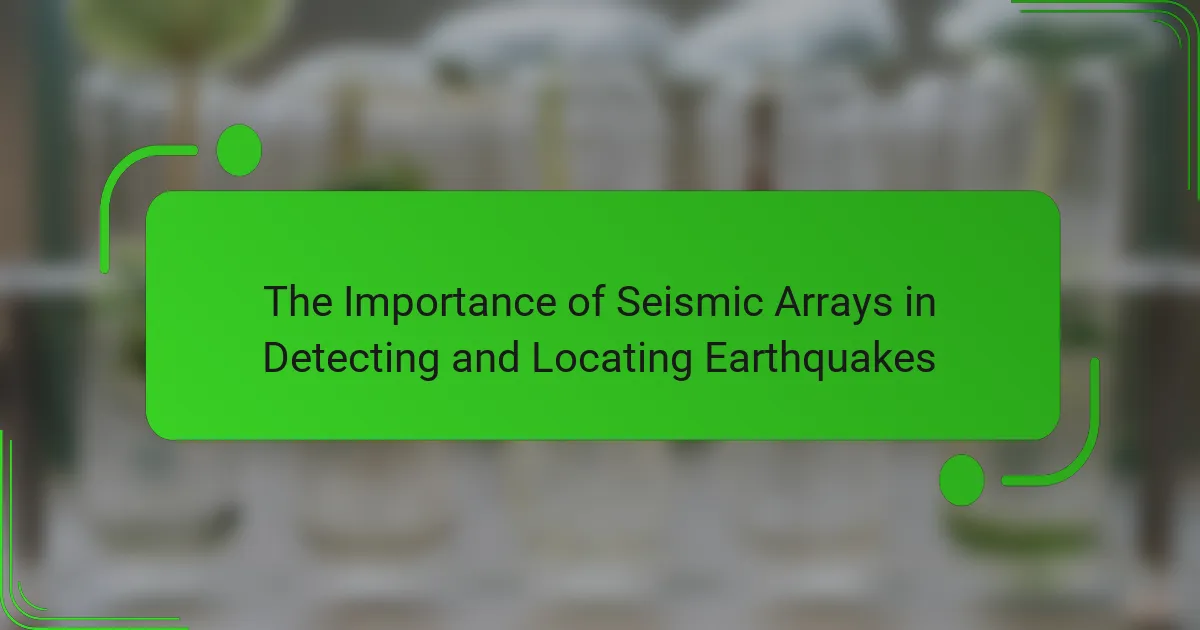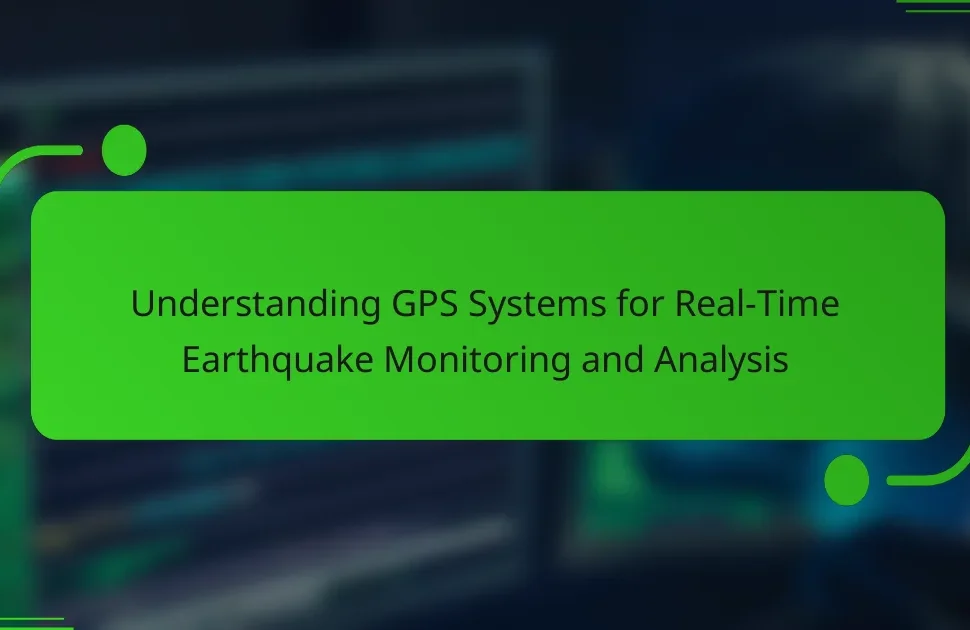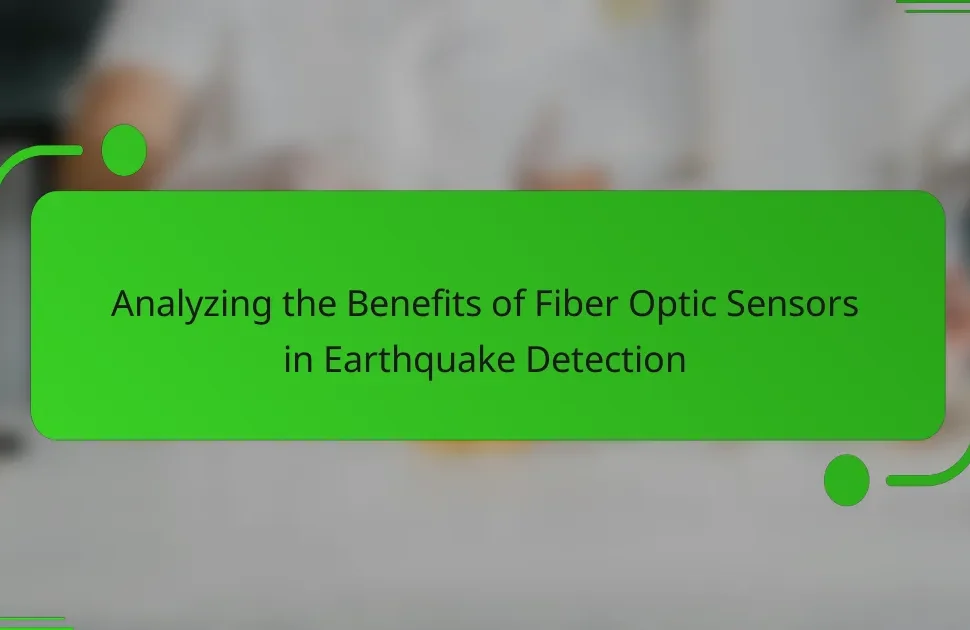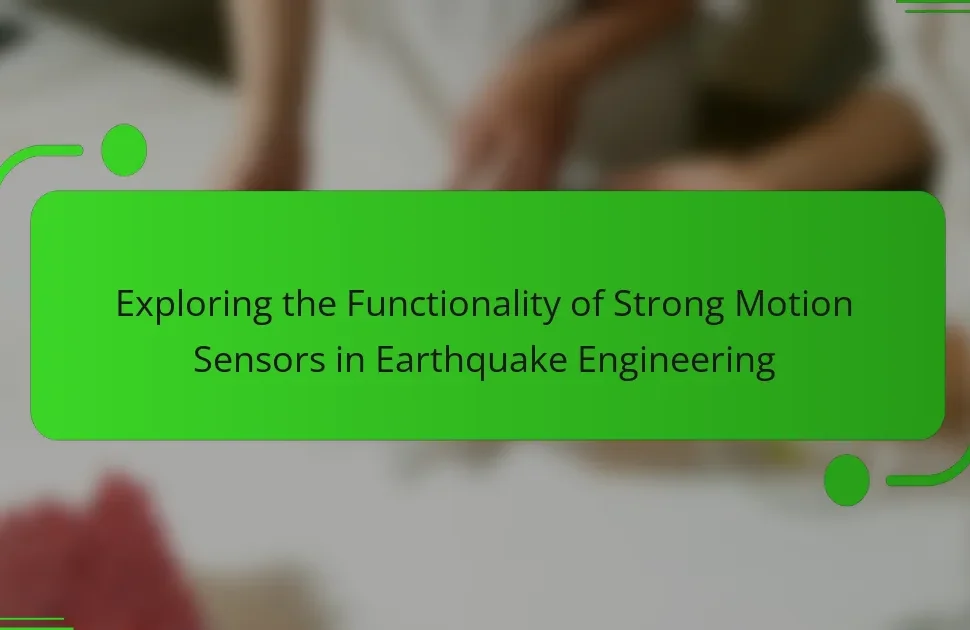Seismic arrays are networks of seismic sensors strategically deployed to detect and analyze seismic waves generated by earthquakes. Each sensor measures ground motion and transmits data to a central processing unit for analysis, enabling the determination of an earthquake’s location, depth, and magnitude. This article highlights the advantages of seismic arrays over single sensors, including improved detection capabilities, reduced noise interference, and enhanced spatial resolution, which allow for the identification of smaller earthquakes. It also discusses potential advancements in sensor technology and data processing methods that could further enhance earthquake detection and monitoring efforts globally.
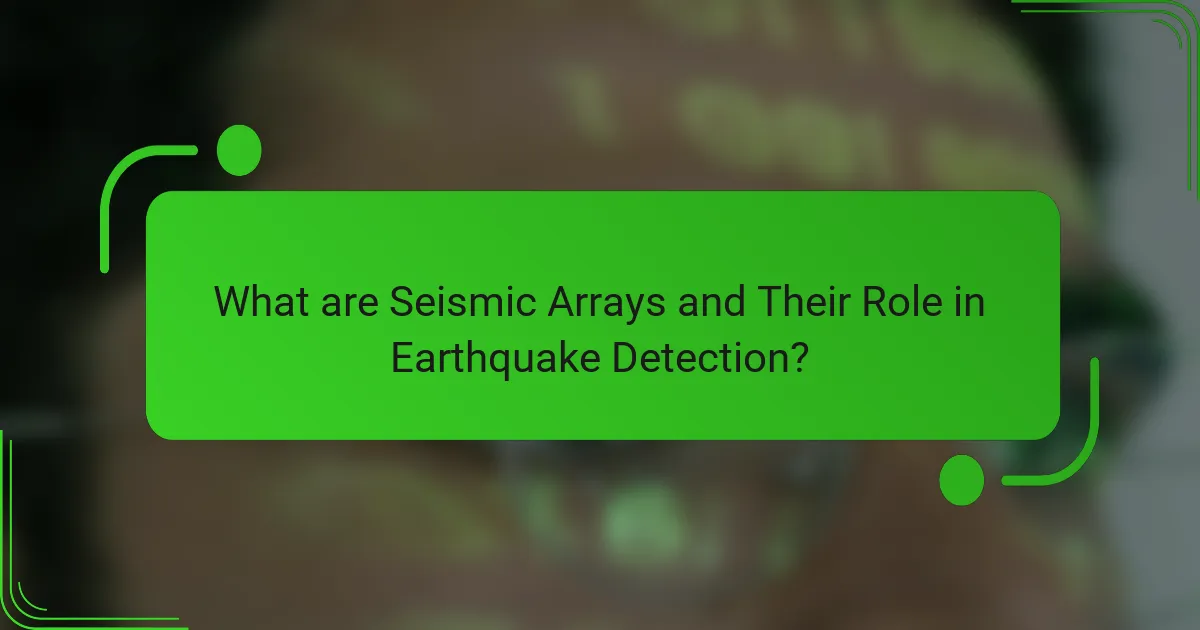
What are Seismic Arrays and Their Role in Earthquake Detection?
Seismic arrays are networks of seismic sensors deployed in a specific geographic area. They work together to detect and analyze seismic waves generated by earthquakes. Each sensor in an array measures ground motion and transmits data to a central processing unit. This data is then analyzed to determine the location, depth, and magnitude of an earthquake. Seismic arrays enhance detection capabilities by providing more accurate and detailed information compared to single sensors. For example, the USGS operates numerous seismic arrays across the United States to monitor seismic activity effectively. The use of arrays allows for quicker response times during seismic events, improving public safety and disaster preparedness.
How do seismic arrays function in monitoring seismic activity?
Seismic arrays function by using multiple sensors to detect ground motion. These sensors measure vibrations caused by seismic waves. The data collected is analyzed to determine the location and magnitude of seismic events. Each sensor in the array provides real-time information. This helps in triangulating the source of the seismic activity. The use of multiple sensors increases the accuracy of detection. Seismic arrays can also distinguish between different types of seismic waves. This capability enhances the understanding of the earthquake’s characteristics.
What technologies are used in seismic arrays for data collection?
Seismic arrays utilize several technologies for data collection. These include broadband seismometers, accelerometers, and GPS sensors. Broadband seismometers measure ground motion over a wide frequency range. Accelerometers detect rapid movements during seismic events. GPS sensors provide precise location data for monitoring shifts in the Earth’s crust. Data from these technologies is transmitted to processing centers for analysis. This combination enhances the accuracy of earthquake detection and location. The integration of these technologies enables real-time monitoring of seismic activity. This is critical for understanding earthquake dynamics and improving safety measures.
How is data from seismic arrays processed to detect earthquakes?
Data from seismic arrays is processed using a series of steps to detect earthquakes. First, sensors in the array capture ground motion vibrations. These vibrations are converted into electrical signals. The signals are then transmitted to a central processing unit. The processing unit analyzes the signals for patterns indicative of seismic activity. Algorithms filter out noise to identify significant seismic events. Once an event is detected, its location and magnitude are calculated. This information is crucial for issuing alerts and assessing potential impacts. Studies show that seismic arrays improve detection accuracy and response time for earthquakes.
Why are seismic arrays critical for earthquake location accuracy?
Seismic arrays are critical for earthquake location accuracy because they enhance the detection of seismic waves. These arrays consist of multiple sensors distributed over a wide area. They capture data from various angles and distances. This spatial distribution allows for precise triangulation of an earthquake’s epicenter.
Seismic arrays improve the signal-to-noise ratio. This results in clearer readings of seismic events. Enhanced clarity helps differentiate between local and distant earthquakes. Studies show that seismic arrays can reduce location errors significantly. For instance, the USGS reports that array data can improve location precision by up to 30%.
Overall, the use of seismic arrays is essential for accurate earthquake monitoring and response.
What methods do seismic arrays use to triangulate earthquake epicenters?
Seismic arrays use triangulation methods to determine earthquake epicenters. They analyze seismic waves generated by earthquakes. These waves travel at different speeds depending on their type. Seismic sensors detect these waves at various locations. The time difference in wave arrival at multiple sensors helps calculate the distance to the epicenter. This process involves using the P-wave and S-wave arrival times. The P-wave travels faster than the S-wave, providing critical timing information. By plotting these distances on a map, scientists can pinpoint the epicenter’s location. This method enhances the accuracy of earthquake detection and monitoring.
How does the density of seismic arrays influence detection precision?
The density of seismic arrays directly impacts detection precision. Higher density arrays provide more data points for analysis. This increased data improves the ability to pinpoint seismic events accurately. It enhances the resolution of seismic signals. Studies show that denser arrays can reduce location errors significantly. For instance, a study by the USGS found that denser networks improved location precision by up to 50%. This precision is crucial for early warning systems and understanding seismic hazards. Therefore, increasing the density of seismic arrays is vital for enhanced detection capabilities.
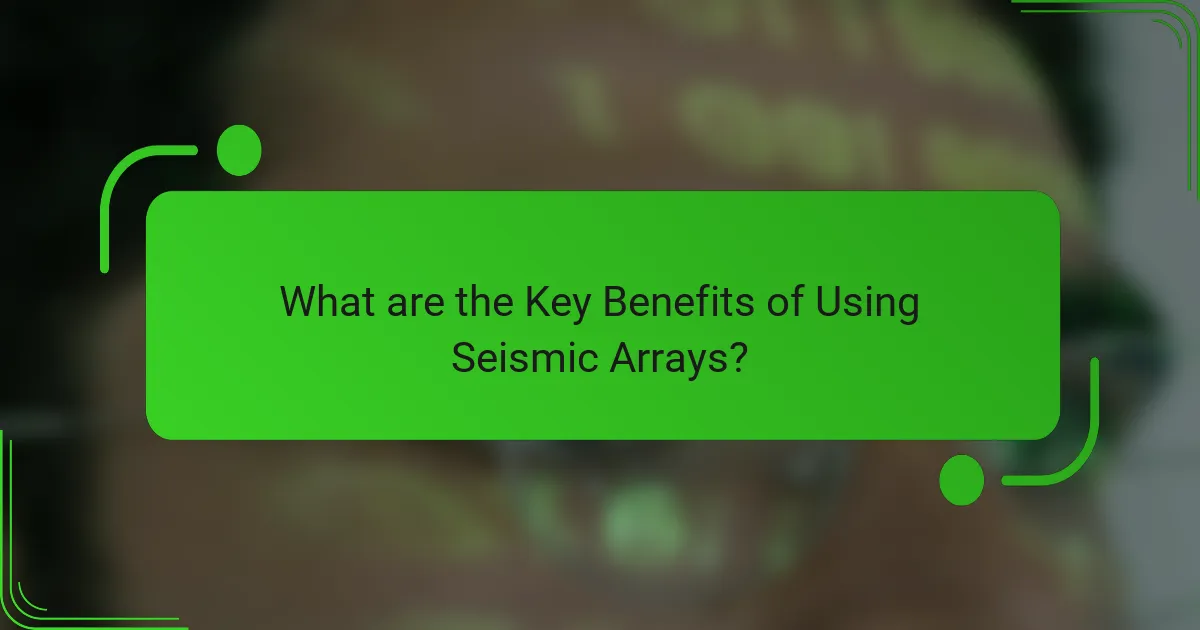
What are the Key Benefits of Using Seismic Arrays?
Seismic arrays enhance earthquake detection and location accuracy. They consist of multiple sensors that work together. This setup allows for improved spatial resolution in detecting seismic waves. Seismic arrays can differentiate between various types of seismic waves. They reduce noise interference, leading to clearer data capture. The combination of multiple data points increases the reliability of earthquake magnitude assessments. Studies show that seismic arrays can detect smaller earthquakes that single sensors might miss. Their deployment in diverse geographical areas supports global earthquake monitoring efforts.
How do seismic arrays enhance public safety during seismic events?
Seismic arrays enhance public safety during seismic events by providing real-time data on earthquake activity. These systems consist of multiple sensors distributed over a geographic area. They detect ground motion and analyze seismic waves from earthquakes. This information allows for quicker assessment of an earthquake’s magnitude and location. Timely data enables emergency services to respond more effectively. For instance, the ShakeAlert system in California uses seismic arrays to issue early warnings. Studies show that early warnings can reduce injuries and fatalities by allowing people to take protective actions. Thus, seismic arrays play a crucial role in mitigating the impacts of seismic events.
What role do seismic arrays play in early warning systems?
Seismic arrays play a crucial role in early warning systems by detecting and analyzing seismic waves. These arrays consist of multiple sensors that capture ground motion from earthquakes. They provide real-time data on the location and magnitude of seismic events. This information allows for rapid assessment of earthquake impacts. Early warning systems utilize this data to alert populations before shaking occurs. Research shows that timely alerts can reduce injuries and fatalities. For instance, the ShakeAlert system in California successfully uses seismic arrays for this purpose. The integration of seismic arrays enhances the effectiveness of earthquake early warning systems.
How does real-time data from seismic arrays contribute to emergency response?
Real-time data from seismic arrays significantly enhances emergency response during earthquakes. This data allows for immediate detection of seismic events. It provides critical information about the earthquake’s location, magnitude, and depth. Emergency services can access this data within seconds of an earthquake occurring. This rapid information flow enables quicker decision-making for evacuations and resource allocation. According to the US Geological Survey, timely data can reduce response times by up to 30%. Additionally, real-time data supports the development of early warning systems. These systems can alert populations seconds before shaking begins, potentially saving lives.
What challenges do seismic arrays face in earthquake detection?
Seismic arrays face several challenges in earthquake detection. One major challenge is noise interference from environmental sources. This noise can obscure seismic signals, making detection difficult. Another challenge is the spatial distribution of sensors. Unevenly spaced sensors can lead to gaps in data coverage. Additionally, the calibration of sensors is crucial. Miscalibrated sensors can produce inaccurate readings. The complexity of seismic waves also poses a challenge. Different types of waves can complicate interpretation. Lastly, data processing and analysis require advanced algorithms. These algorithms must effectively filter noise and enhance signal clarity.
How do environmental factors affect the performance of seismic arrays?
Environmental factors significantly affect the performance of seismic arrays. These factors include soil composition, temperature, and moisture levels. Soil composition influences wave propagation speed and attenuation. For example, seismic waves travel faster in solid rock than in loose soil. Temperature variations can impact the sensitivity of sensors. Higher temperatures may cause thermal noise, reducing data clarity. Moisture levels can alter the conductivity of the ground, affecting signal quality. Additionally, vegetation and urban structures can obstruct seismic signals. Studies show that arrays in densely populated areas may experience more noise interference. Overall, understanding these environmental influences is crucial for optimizing seismic array performance.
What are the limitations of current seismic array technologies?
Current seismic array technologies have several limitations. They often struggle with low-frequency detection, which can miss smaller earthquakes. Spatial resolution can be insufficient in sparsely populated areas. Data processing can be slow, leading to delayed alerts. Environmental noise can interfere with signal clarity. Calibration of instruments can vary, affecting data accuracy. Costs of installation and maintenance can be prohibitive for some regions. Additionally, some technologies may not effectively differentiate between seismic signals and non-seismic noise. These limitations can hinder the overall effectiveness of seismic monitoring systems.
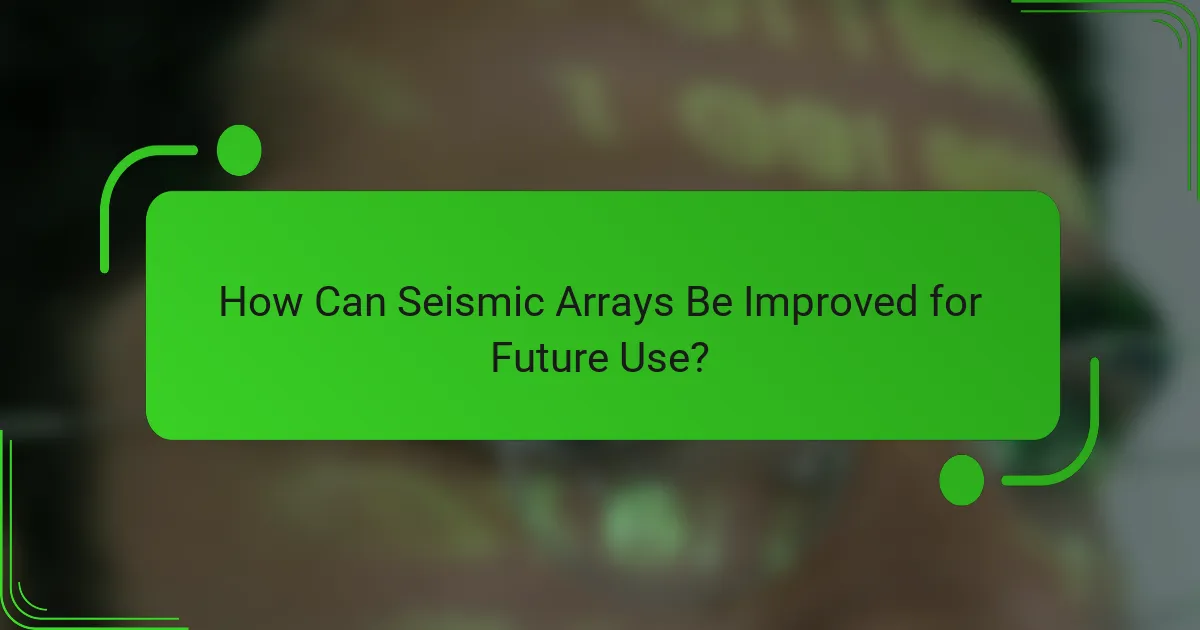
How Can Seismic Arrays Be Improved for Future Use?
Seismic arrays can be improved for future use by enhancing sensor technology and data processing methods. Upgrading sensors to higher sensitivity can capture more subtle seismic waves. Implementing machine learning algorithms can improve data interpretation and anomaly detection. Increasing the density of sensor networks can provide better spatial resolution. Integrating real-time data sharing among institutions can enhance collaborative analysis. Developing standardized protocols for data collection can ensure consistency across different arrays. Investing in research for new materials can lead to more durable sensors. These improvements can lead to more accurate earthquake detection and location capabilities.
What advancements are being made in seismic array technology?
Recent advancements in seismic array technology include the development of dense sensor networks. These networks improve the spatial resolution of seismic data collection. Enhanced algorithms for data processing have also been introduced. They allow for faster and more accurate earthquake detection. Additionally, integration of machine learning techniques is becoming common. This integration helps in identifying patterns in seismic activity. Advances in wireless technology have enabled remote monitoring. This capability allows for real-time data transmission from remote locations. These improvements collectively enhance the effectiveness of seismic monitoring systems.
How can machine learning enhance the capabilities of seismic arrays?
Machine learning can enhance the capabilities of seismic arrays by improving data analysis and interpretation. It enables the automatic detection of seismic events, reducing the reliance on human analysts. Machine learning algorithms can identify patterns in vast datasets that traditional methods may miss. This leads to more accurate earthquake location and magnitude estimation. For instance, deep learning models have shown a 30% improvement in event detection rates compared to conventional techniques. Additionally, machine learning can optimize the placement of sensors within seismic arrays to maximize data collection efficiency. This technology also allows for real-time processing of seismic data, facilitating quicker response to seismic events. The integration of machine learning into seismic monitoring systems represents a significant advancement in earthquake detection and analysis.
What new materials or designs are being researched for seismic arrays?
New materials and designs being researched for seismic arrays include advanced fiber optics and nanomaterials. These innovations aim to enhance sensitivity and data acquisition capabilities. Researchers are exploring the use of distributed acoustic sensing (DAS) with fiber optic cables. DAS can provide high-resolution spatial data over long distances. Additionally, nanomaterials are being tested for their ability to improve sensor performance. Studies indicate that these materials can lead to more compact and efficient seismic sensors. Research published in the journal “Nature” highlights the potential of these technologies to revolutionize seismic monitoring. The authors emphasize their ability to detect smaller seismic events with greater accuracy.
What best practices should be followed for effective seismic monitoring?
Effective seismic monitoring requires the implementation of several best practices. First, establishing a dense network of seismic sensors enhances data accuracy. This network should cover both urban and rural areas to capture a wide range of seismic activity. Regular calibration of instruments ensures reliable measurements. Data should be collected continuously to monitor seismic events in real-time. Utilizing advanced algorithms for data analysis improves event detection and location. Collaboration with local geological agencies can provide valuable insights into regional seismicity. Training personnel in data interpretation is crucial for accurate reporting. Lastly, maintaining open communication with the public about seismic risks fosters community preparedness.
How often should seismic arrays be maintained for optimal performance?
Seismic arrays should be maintained at least once a year for optimal performance. Regular maintenance ensures that all components function correctly. It involves checking sensors, data acquisition systems, and communication links. Annual checks help identify potential issues before they affect data quality. Some organizations may choose to perform maintenance biannually for added reliability. This frequency aligns with industry best practices. Regular maintenance is essential for accurate earthquake detection and location. It ensures the integrity of the data collected by the seismic networks.
What training is necessary for personnel operating seismic arrays?
Personnel operating seismic arrays require specialized training in seismology and data analysis. This training includes understanding seismic wave propagation and earthquake mechanics. Operators must also learn to configure and maintain seismic equipment. Familiarity with data collection methods is essential for accurate measurements. Training in software used for data interpretation is critical. Knowledge of safety protocols during fieldwork is necessary. Continuous education on advancements in seismic technology is recommended. These training components ensure effective monitoring and analysis of seismic activity.
Seismic arrays are networks of seismic sensors designed to detect and analyze seismic waves generated by earthquakes, providing critical data on their location, depth, and magnitude. This article explores the functioning of seismic arrays, including the technologies employed for data collection, processing methods, and the role of these systems in enhancing earthquake detection accuracy. Additionally, it discusses the benefits of seismic arrays for public safety, their impact on early warning systems, and the challenges faced in seismic monitoring. Advancements in technology, best practices for effective monitoring, and necessary training for personnel operating these arrays are also highlighted, emphasizing the importance of seismic arrays in improving earthquake preparedness and response.
